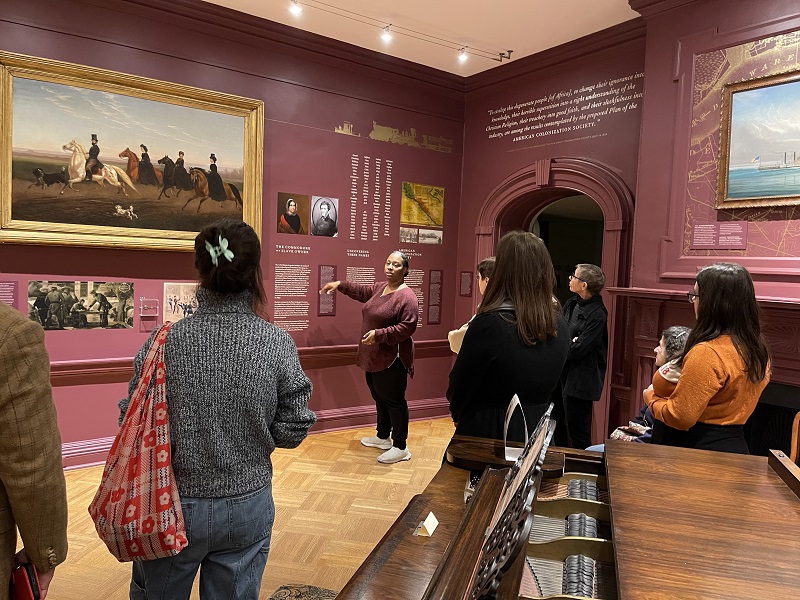Lives of Those Enslaved at Morven Featured In Reopened, Updated History Exhibition
LIVES OF THE ENSLAVED: Morven Museum and Garden recently reopened its exhibition “Historic Morven: A Window Into America’s Past,” which has been updated with new information about individuals enslaved by the Stockton family. Research and archival consultant Sharece Blakney is shown leading a tour of the exhibition. (Photo courtesy of Morven Museum and Garden)
By Donald Gilpin
Morven, built in the 1750s, has been the home of many of New Jersey’s most prominent citizens, starting with Richard Stockton, one of the signers of the Declaration of Independence, followed by four more generations of Stocktons, Robert Wood Johnson Jr., and then five New Jersey governors as the state’s first Governor’s Mansion before becoming a museum in 2004.
But Morven has also been home to many people who are much less well known, who were enslaved by the Stockton family.
With the recent reopening of its permanent history exhibition,” Historic Morven: A Window Into America’s Past,” Morven Museum and Garden, located at 55 Stockton Street, has provided extensive research updates in three of the museum’s first-floor galleries, and the lives of the enslaved residents of Morven are portrayed in much greater depth and detail. Morven’s “Window Into America’s Past” reveals a much more expansive and complex landscape than has been seen in the past.
“This updated exhibition is the culmination of three years of work, and we are very pleased to present a fuller picture of the lives of people like Kate and Anthony, who were born into slavery at Morven,” said Morven Museum Deputy Director and Curator Elizabeth Allan. “We look forward to continuing research into these lives previously left out of the historical record.”
Research and archival consultant Sharece Blakney worked with Morven curators to uncover new information about Morven’s enslaved residents from tax documents, wills, letters, ledgers, and census records found in the Somerset County Clerk’s Office, Princeton Theological Seminary, the New Jersey State Archives and the National Archives.
One of Blakney’s most remarkable discoveries was the names of 108 people enslaved by Commodore Robert Field Stockton and his wife Harriet on the sugar cane plantation they owned in Georgia during the time they lived at Morven. Blakney found the names of these people in deed books in Glynn County, Georgia, where they are recorded as transfers of property in the spring of 1827.
In two transactions, Stockton purchased the 108 people for a total of $31,200 and was also guaranteed, according to the deed, “the future issue and increase of the female slaves,” meaning he would own the children born to these enslaved women. These 108 names are included in the Morven exhibition, 39 of them children under the age of 10.
Visitors to the updated exhibition can explore the stories of Marcus Marsh, who was enslaved by Richard and Annis Stockton and later lived as a free man in Philadelphia; Sampson, who self-emancipated from Richard Stockton, the Duke; and Phillis and her son Anthony, born in 1806, both enslaved by Richard Stockton. Anthony would have grown up alongside the Stocktons’ three youngest children.
Also revealed in the exhibit is a window into the life of Hannibal Simpson, who was manumitted by Robert Field Stockton in 1829 and went on to live as a free man in West Windsor in a community of free Black people; Thomas Jewell, who was manumitted by Richard Stockton, the Duke, in 1823, after which he also lived in West Windsor and later in Princeton, where he was the head of his own household; and Kate or Catherine, born at Morven in 1804, manumitted by Robert Field Stockton, the Duke’s son, in 1829, along with other clues that are difficult to trace in piecing together her life’s story.
The Morven Museum updates represent 900 hours of grant and privately funded research by Blakney, who also helped write an interpretative plan for the new information. This research and its incorporation into Morven’s permanent exhibition was made possible by Fulton Bank, and the Mercer County Cultural and Heritage Commission through funding from the Mercer County Board of Commissioners and the New Jersey Historical Commission.
Allan points out that the research is ongoing, and that Morven plans to launch a new website this year with additional findings that are too extensive to fit on the walls of the museum.
“Morven also recently received its first grant from the National Endowment for the Humanities for the creation of an inclusive history gallery, which will allow more space for us to share new discoveries into the lives of those previously left out of our historical record,” Allan said.


